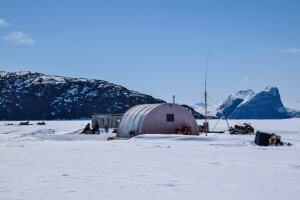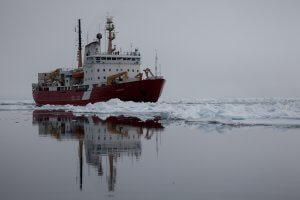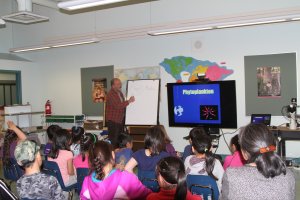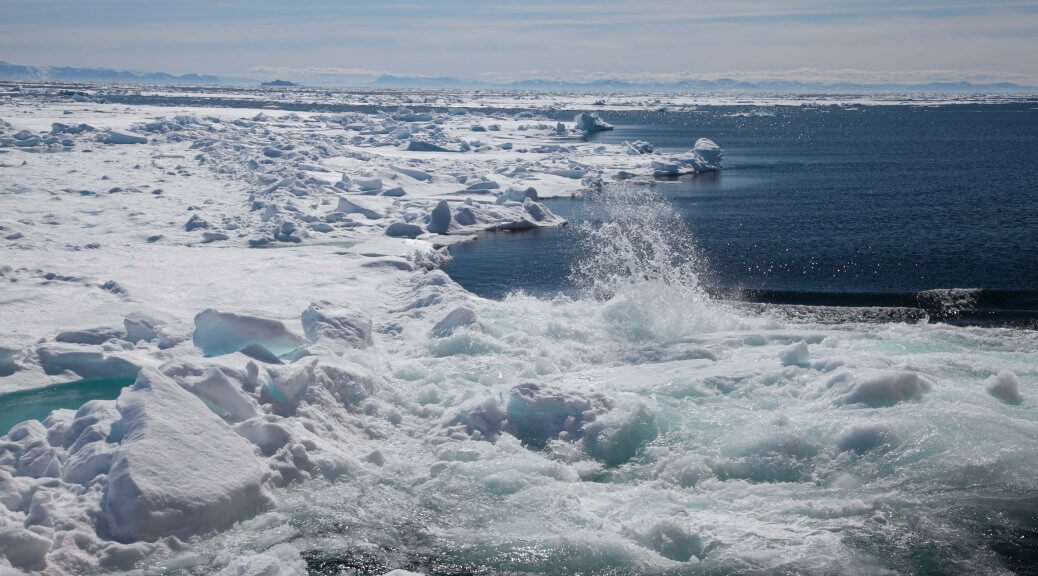The last sampling day occurred two weeks ago at the GreenEdge ice camp, on July 22th. The final team to leave Qikiqtarjuaq contacted me on July 27th from Iqaluit, which means WE DID IT! All the instruments are in Sea-Cans ready to be returned to Quebec City on the sealift, the samples were transferred to the CCGS Amundsen and will return to Quebec City in October. Now is the time to do a little recap of the operations. Everything, or almost everything, went according to plan, and we suffered no major injuries or losses of equipment.

At the ice camp, we sampled a total of 36 stations from completely ice and snow covered conditions to the last station on the ice edge, sampled from the air-boat, which had been delivered by the Amundsen and its GreenEdge science team. The Amundsen even completed the data set with one final station in open water. We measured background winter conditions as well as processes under conditions of ice algae and phytoplankton blooms. A total of 52 people contributed to the ice camp efforts over a 98-day period (21 April to 27 July), measuring a total of 70 variables to characterize the physical, chemical and biological ecosystems in and under the land-fast sea ice. We even had the GreenEdge Amundsen science crew change in Qikiqtarjuaq, with an additional 17 participants in
transit at the GreenEdge ice camp facilities. To accommodate the science activity and the participants, the GreenEdge team made use of the school laboratory, the local ‘coffee shop’ for a maintenance and storage area as well as four houses in the community. To add a bit of spice to the logistical operations, airplanes, which are scheduled to land in Qikiqtarjuaq 6 days a week, must rely on visual navigation. Cloud cover and fog can be very problematic in the area during May and June, the sampling period of the GreenEdge project.

Flight cancellations and logistical reorganisation were a regular issue this year. To support ice camp logistics and science operations, a total of 1 ton of food and 4,5 tons of equipment was shipped to the ice camp. We hired 10 local staff as wildlife monitors, janitors and assistant cooks. Overall, the ice camp operations represented an ambitious logistical challenge, which was overcome with success due to the dedicated work of our chief scientist, Joannie and myself, and coordinators Debbie and Andrew. The science operations would simply not have been possible without the contribution of the Takuvik professional team (José, Guislain, Cyril, Jade, Constance and Anita) who put in place the infrastructure and ensured the day-to-day operations. A special mention to Eric, our ‘chef de camp’ who oversaw the safety of the operations, maintained the equipment and assisted scientists in complex field operations. Finally, we want to acknowledge the municipality of Qikiqtarjuaq, Nattivak Hunters and Trappers Organization and Inuksuit School, for their support of the ice-camp Green Edge campaign.

Parallel to the ice camp operations, we had 52 GreenEdge participants onboard the CCGS Amundsen between June 3 and July 14, some for a 3-week leg, and some for the 6-week leg. In addition to all of the variables that were measured at the ice-camp, the Amundsen science crew also deployed autonomous platforms (gliders and Bio-Argo floats), had an elaborate physical oceanography program, and conducted detailed measurements of processes occurring in the water-column. Although the Amundsen crew did not observe much ice algae activity because of the timing of the mission, this information is well documented from the ice camp time series. However, they did complete 7 transects, with a total of 141 stations, going from pre-bloom, to full bloom and post-bloom conditions. They even observed a Phaeocystis bloom, which according to the chief scientists, Marcel Babin and Jean-Éric Tremblay, has never been observed at such a high latitude in Baffin Bay.

Prior to departure, all consumables and equipment had to be purchased or shipped to Quebec City. Care was taken to ensure that there were adequate supplies to complete all of the science operations that were going to take place during the mission, because once the ice-breaker leaves Quebec City, there are no opportunities to restock the laboratory shelves. Thanks to Flavienne’s exceptional organisational skills, everything went according to plan. During the first 3 week leg, GreenEdge also benefited from having the Amundsen coordinator and Marine research manager, Keith Levesque, aboard. He contributed to the safety and the smooth flow of the day-to-day operations. Finally, the autonomous platform program, a new component of the Takuvik activities, was a success thanks to the preparation of Guislain, Eric, Claudie and José.
All operations, both at the ice camp and on the Amundsen, were supported by the remote sensing services of Takuvik, and more specifically by Maxime Benoît Gagné, who provided daily images of the ice distribution and chlorophyll concentration. This contributed to increasing the safety of the operations, identifying the field stations for the Amundsen, and ensuring the success of the campaign.

Finally, GreenEdge has dedicated a large component of its program to the human component: social science, communication and outreach activities, which was brilliantly coordinated by Julie. First, interviews, supported by a hunting camp, led us to gather Inuit knowledge, essential to build a food security model. Second, we had a film crew, Parafilms, both on the Amundsen and at the ice camp to document the science activities, which will be the foundation for a 52-min documentary as well as provide the material for 12 educational web-documentaries on various Arctic-related topics. Third, Julie elaborated an outreach program both in Qikiqtarjuaq with the local elementary and high school and on the Amundsen with schools in France. Fourth and finally, she put in place a beautiful and informative blog, with over 100 posts during this 2016 edition of the GreenEdge campaign. Every morning, I had the pleasure of reading new posts from the GreenEdge participants about their science, their challenges during their field activities, and their perception of their working environment.

The numbers that characterize the 2016 GreenEdge campaign are very impressive, but what I remember most about my experience in Qikiqtarjuaq and the overall implementation of the GreenEdge project, is the passion of the scientists and the good spirit of the team even when working under elevated stress (and suffering from sleep deprivation!!). To ensure the success of the 2016 edition of the GreenEdge project, the whole team worked very hard for over a year to carefully plan the operations. I’m very proud of what we have achieved, and feel so grateful to work with such a smart, dedicated and enthusiastic team. Chapeau à toute l’équipe!!

Marie-Hélène Forget and the coordination team


